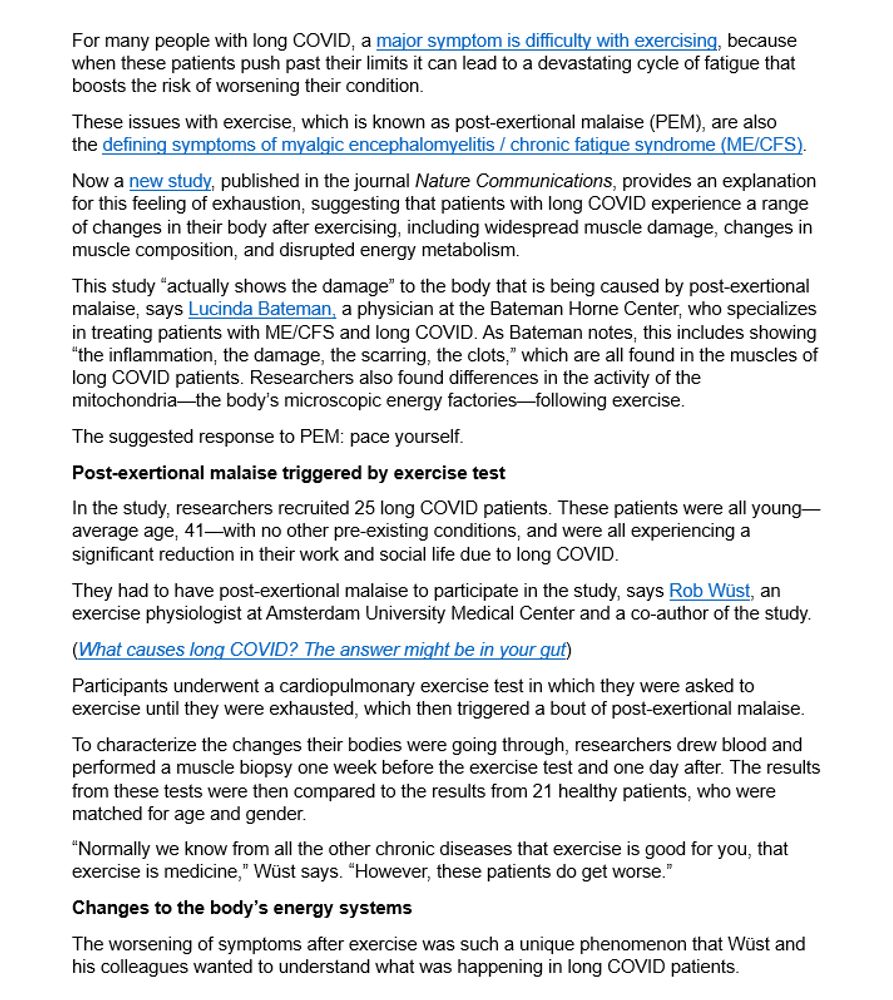Record🤔
cid:
"bafyreifl46pmkvcktngm57t3ymgcnivh54k2mxdokq3offj3tv2px75nwa"
value:
text:
"Long COVID can destroy your ability to exercise. Now we know why | National Geographic "As a new study shows, the answer lies in some long COVID sufferers’ muscle damage and their bodies’ ability to make energy." #LongCOVID #COVIDisNotOver Source: www.nationalgeographic.com/premium/arti..."
$type:
"app.bsky.feed.post"
embed:
$type:
"app.bsky.embed.images"
images:
alt:
"Long COVID can destroy your ability to exercise. Now we know why. As a new study shows, the answer lies in some long COVID sufferers’ muscle damage and their bodies’ ability to make energy. BY RACHEL FAIRBANK - PUBLISHED FEBRUARY 15, 2024"
image:
View blob content
$type:
"blob"
mimeType:
"image/jpeg"
size:
354745
aspectRatio:
width:
734
height:
775
alt:
"For many people with long COVID, a major symptom is difficulty with exercising, because when these patients push past their limits it can lead to a devastating cycle of fatigue that boosts the risk of worsening their condition. These issues with exercise, which is known as post-exertional malaise (PEM), are also the defining symptoms of myalgic encephalomyelitis / chronic fatigue syndrome (ME/CFS). Now a new study, published in the journal Nature Communications, provides an explanation for this feeling of exhaustion, suggesting that patients with long COVID experience a range of changes in their body after exercising, including widespread muscle damage, changes in muscle composition, and disrupted energy metabolism. This study “actually shows the damage” to the body that is being caused by post-exertional malaise, says Lucinda Bateman, a physician at the Bateman Horne Center, who specializes in treating patients with ME/CFS and long COVID. As Bateman notes, this includes showing “the i"
image:
View blob content
$type:
"blob"
mimeType:
"image/jpeg"
size:
353619
aspectRatio:
width:
713
height:
798
alt:
"Key changes they discovered were differences in the body’s ability to generate energy compared to healthy patients. This included lower levels of oxidative phosphorylation—a biochemical process that yields ATP, a molecule that the body uses for energy. They also observed that after exercise there was a decrease in the activity of mitochondria, cellular power stations that manufacture the ATP molecules. “Their mitochondrial function is impaired rapidly upon exercise,” Wüst says. “This can make them go into a vicious cycle, because every time they overexert themselves, they get a crash in their mitochondrial function and their metabolism.” The impact on the body’s ability to manufacture energy are also echoed by the results from experiments where patients with post-exertional malaise performed two exercise tests—24 hours apart—in which they were asked to exercise until exhausted. During the exercise test on the second day, patients with post-exertional malaise showed an impaired ability"
image:
View blob content
$type:
"blob"
mimeType:
"image/jpeg"
size:
352766
aspectRatio:
width:
707
height:
789
alt:
"Fast-twitch muscle fibers are used for quick, explosive movements, such as lifting heavy objects or sprinting, while slow-twitch muscle fibers are used for slower, steadier activity, such as walking or endurance running. “We know that it is difficult to change fiber types in people, and that it doesn’t happen with inactivity,” Wüst says. “Something else is changing the fiber types.” Although they don’t know what is driving this change, it may help explain some of the fatigue that patients are experiencing. “[Fast-twitch muscle fibers] use energy quicker, and therefore they fatigue quicker,” Wüst says. Changes to the body’s ability to recover In addition to the changes in the body’s ability to use energy, and the composition of muscle fibers, Wüst and his collaborators also found evidence of muscle damage. In a healthy person, “muscles get torn down and built up, that’s how you get better after you exercise,” says Maureen Hanson, a molecular biologist at Cornell University, whose resear"
image:
View blob content
$type:
"blob"
mimeType:
"image/jpeg"
size:
321972
aspectRatio:
width:
781
height:
778
langs:
"en"
facets:
index:
byteEnd:
229
byteStart:
219
features:
tag:
"LongCOVID"
$type:
"app.bsky.richtext.facet#tag"
index:
byteEnd:
245
byteStart:
230
features:
tag:
"COVIDisNotOver"
$type:
"app.bsky.richtext.facet#tag"
index:
byteEnd:
297
byteStart:
255
features:
uri:
"https://www.nationalgeographic.com/premium/article/post-exertional-malaise-me-cfs-exercise-energy"
$type:
"app.bsky.richtext.facet#link"
createdAt:
"2024-02-16T01:18:47.440Z"



